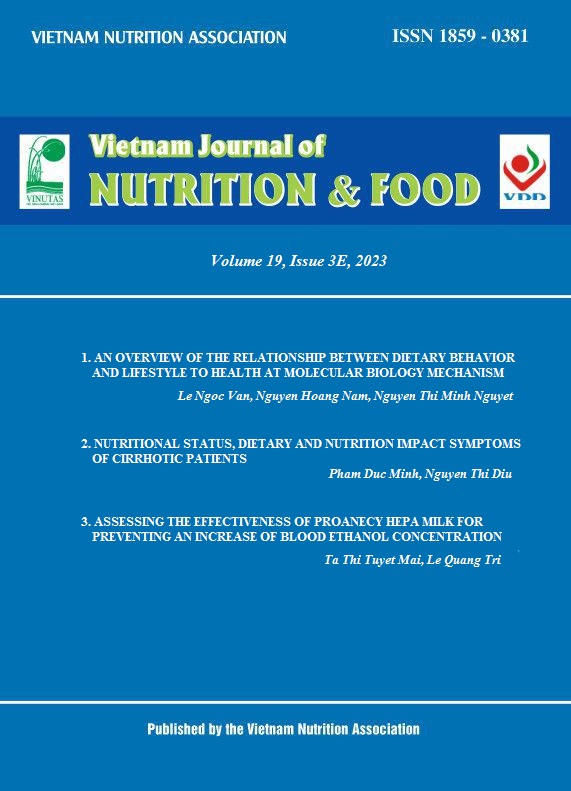XÂY DỰNG QUY TRÌNH PCR VỚI 2 CẶP MỒI ĐỐI CHIỀU ĐỂ PHÂN TÍCH KIỂU GEN CỦA ĐA HÌNH rs1801133 GEN 𝘔𝘛𝘏𝘍𝘙 Ở NGƯỜI VIỆT NAM
Nội dung chính của bài viết
Tóm tắt
Mục tiêu: Xây dựng quy trình nhân gen (PCR) với 2 cặp mồi đối chiều để xác định kiểu gen của rs1801133 trên gen MTHFR ở người Việt Nam
Phương pháp: Mẫu ADN của 15 người Việt Nam được sử dụng làm mẫu thử nghiệm. Phương pháp giải trình tự gen Sanger dùng để xác định kiểu gen chuẩn cho phản ứng PCR. Các mồi trong phản ứng PCR được thiết kế theo nguyên lý của kỹ thuật 2 cặp mồi đối chiều (confronting two-pair primers, CTPP). Các quy trình thí nghiệm đã được thực hiện để xác định tỷ lệ nồng độ mồi vòng trong và vòng ngoài, nhiệt độ bắt cặp và chu trình nhiệt của phản ứng PCR.
Kết quả: Xây dựng thành công quy trình PCR-CTPP với 2 cặp mối đối chiều trong cùng một phản ứng với sự tối ưu của mồi, chu trình nhiệt và thành phần phản ứng PCR để phát hiện kiểu gen của rs1801133.
Kết luận: Quy trình PCR-CTPP này có thể áp dụng với cỡ mẫu lớn để xác định tỷ lệ kiểu gen và phân tích mối liên quan giữa đa hình rs1801133 trên gen MTHFR với hội chứng chuyển hóa ở người Việt Nam.
Từ khóa
rs1801133, gen MTHFR, PCR với 2 cặp mồi đối chiều
Chi tiết bài viết
Tài liệu tham khảo
2. Huong NT, Thuoc ĐP, Chi LV. Epidemiological characteristics, risk factors of metabolic syndrome in the population of Thua Thien Hue Province. Journal of Vietnam Heart Association . 2021;(98):142-150. doi:10.58354/jvc.98.2021.109
3. Anh PTV, Cuong LĐ, Nhung NT. Some asociated factors with metabolic syndrome in people aged 25-64 years old in Thai Binh province. Journal of Community Medicine. 2023;64(1). doi:10.52163/yhc.v64i1.575
4. Frosst P, Blom HJ, Milos R, et al. A candidate genetic risk factor for vascular disease: a common mutation in methylenetetrahydrofolate reductase. Nat Genet. 1995;10(1):111-113. doi:10.1038/ng0595-111
5. Real JT, Martinez-Hervas S, Garcia-Garcia AB, et al. Association of C677T Polymorphism in MTHFR Gene, High Homocysteine and Low HDL Cholesterol Plasma Values in Heterozygous Familial Hypercholesterolemia. Journal of Atherosclerosis and Thrombosis. 2009;16(6):815-820. doi:10.5551/jat.2196
6. Kaur H, Badaruddoza B, Bains V, Kaur A. Genetic association of ADIPOQ gene variants (-3971A>G and +276G>T) with obesity and metabolic syndrome in North Indian Punjabi population. PLOS ONE. 2018;13(9):e0204502. doi:10.1371/journal.pone.0204502
7. Jang Y, Lee JH, Kim OY, et al. The SNP276G>T polymorphism in the adiponectin (ACDC) gene is more strongly associated with insulin resistance and cardiovascular disease risk than SNP45T>G in nonobese/nondiabetic Korean men independent of abdominal adiposity and circulating plasma adiponectin. Metabolism. 2006;55(1):59-66. doi:10.1016/j.metabol.2005.07.007
8. Hoa TN, Nan TN, Hoa TMT, et al. Associationbetween methyl -methylene tetrahydrofolate reductase (MTHFR) C677T polymorphism and osteoporosis in men in men. VMJ. 2022;514(2). doi:10.51298/vmj.v514i2.2634
9. Antonaros F, Olivucci G, Cicchini E, et al. MTHFR C677T polymorphism analysis: A simple, effective restriction enzyme-based method improving previous protocols. Molecular Genetics & Genomic Medicine. 2019;7(5):e628. doi:10.1002/mgg3.628
10. Hamajima N, Saito T, Matsuo K, Kozaki K, Takahashi T, Tajima K. Polymerase Chain Reaction with Confronting Two‐pair Primers for Polymorphism Genotyping. Jpn J Cancer Res. 2000;91(9):865-868. doi:10.1111/j.1349-7006.2000.tb01026.x
11. Little S. Amplification-refractory mutation system (ARMS) analysis of point mutations. Curr Protoc Hum Genet. 2001;Chapter 9:Unit 9.8. doi:10.1002/0471142905.hg0908s07
12. Srejovic I, Jakovljevic V, Zivkovic V, Djuric D. Possible Role of N-Methyl-D-Aspartate Receptors in Physiology and Pathophysiology of Cardiovascular System. Serbian Journal of Experimental and Clinical Research. 2019;20(1):3-13. doi:10.1515/sjecr-2017-0010
13. Platt DE, Hariri E, Salameh P, et al. Type II diabetes mellitus and hyperhomocysteinemia: a complex interaction. Diabetology & Metabolic Syndrome. 2017;9(1):19. doi:10.1186/s13098-017-0218-0.
14. Tinelli C, Di Pino A, Ficulle E, Marcelli S, Feligioni M. Hyperhomocysteinemia as a Risk Factor and Potential Nutraceutical Target for Certain Pathologies. Frontiers in Nutrition. 2019;6. https://www.frontiersin.org/article/10.3389/fnut.2019.00049.
15. Hamajima N, Saito T, Matsuo K, Tajima K. Competitive Amplification and Unspecific Amplification in Polymerase Chain Reaction with Confronting Two-Pair Primers. The Journal of Molecular Diagnostics. 2002;4(2):103-107. doi:10.1016/S1525-1578(10)60688-5


